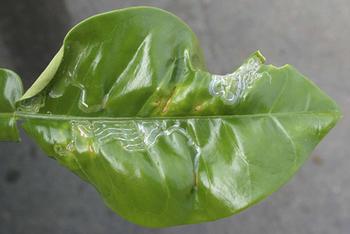Citrus Leafminer
Sometimes the Best Treatment is not to Treat at All
by Jim Farr
 Citrus leafminer damage on leaf including curling of leaves
The Problem and Visible Signs of the Damage
Citrus leafminer damage on leaf including curling of leaves
The Problem and Visible Signs of the Damage

One of the most common questions we get at the Help Desk concerns the Citrus Leafminer. You probably have seen it if you have a citrus tree, especially a lemon tree. The damage to the leaves is very obvious. New growth shows unusual, white squiggly lines like the doodles on paper. The lines are readily visible on the underside of the leaves. Besides the visible lines, the leaves start curling.
The Cause – Citrus Leafminer Moth
Citrus Leafminer Moth (Phyllocnistis citrella)
The cause of this damage is a small moth (Phyllocnistis citrella). The female lays her eggs on the underside of the new leaves. The eggs hatch into tiny, hungry larvae that feed between the layers of the leaves. As they eat their way through the inside of the leaf, they get fatter and the mines get wider. When this “mining” happens to young developing leaves, the leaves deform and look unsightly. But that is pretty much where the bad news ends. If left alone, the branch with the deformed leaves will often still develop normal flowers and produce healthy fruit.

Solution: To Treat or Not to Treat?
The Citrus Leafminer is not active until after the spring flush of flowers and leaves have developed so the flowers are not in jeopardy. The damage is cosmetic and does not affect the tree’s ability to set, size, and ripen normal fruit. Therefore, we do not recommend any type of chemical control for this pest. However, pheromone traps are commercially available to home gardeners. The pheromone traps won't completely eliminate all ovipositing females, but it may lower their numbers in light to moderate infestations so that damage is not as extensive.
An Important Lesson – Sometimes Doing Nothing is Best
This is a great example of where doing nothing is the best approach. As gardeners, we want a quick fix to our gardening problems and often we reach for a fast cure. However, sometimes it is better to do nothing and live with a small amount of damage that ultimately will cause no harm and is seasonal.
There are many examples of this approach in the garden and understanding this lesson can make the life of the gardener easier and more relaxing, focusing energy on areas where it really matters. Small infestations, if they cause mostly cosmetic damage, are often best left alone. Natural predators will often take care of the problem and are far more effective than many pesticides which can make the problems worse by killing the natural predators. As gardeners, it’s a tough lesson but knowing when to take action vs no action is something we can all get better at.
So, if you see signs of Citrus Leafminer on your citrus, don’t be concerned. Your citrus tree is fine, it will not get permanently damaged and you still will get plenty of fruit for you and your neighbors to enjoy.
Have a gardening question? We'll help. You can reach us by:
- Emailing acmg@ucanr.edu. Please include a photo of the problem, if you can, plus your name, phone number, city and a description of the problem.
- Using our online form.
- By phone, during our office hours, 10 am to noon Wednesday and 11 am to 1 pm Thursday: 510-670-5645. At other times, please leave a message and we'll return your call during our office hours.
- In person at our Hayward office, during our office hours, only by appointment.

